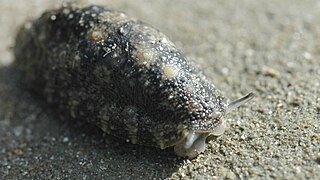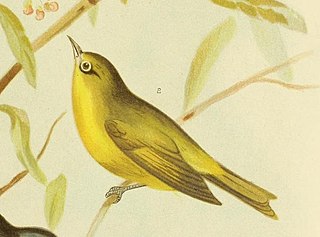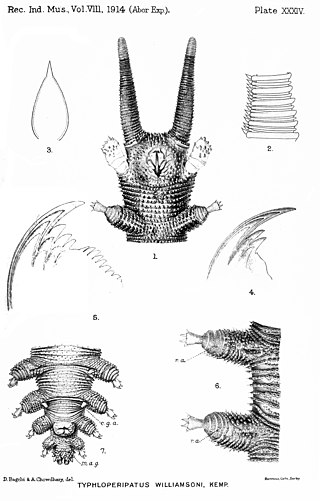
Leptopelis vermiculatus, also known as the peacock tree frog, Amani forest treefrog, or vermiculated tree frog, is a species of frog found in forest areas in Tanzania. Sometimes the common name big-eyed tree frog is used, but this may also refer to another species, Leptopelis macrotis.

The pygmy ribbontail catshark is a species of finback catshark, family Proscylliidae, distributed patchily in the western Indo-Pacific from Tanzania to the Philippines. It occurs around the edges of continental and insular shelves at a depth of 71–766 m (233–2,513 ft), typically on or near mud bottoms. One of the smallest living shark species, the pygmy ribbontail catshark grows to a maximum known length of 24 cm (9.4 in). It has a slender body with a low, ribbon-like tail fin, and is dark brown in color with blackish dorsal fin markings and tail bands. This shark feeds mainly on bony fishes, followed by crustaceans and then squid. It is aplacental viviparous with females bearing litters of 1–2 relatively large pups. It is of minimal significance to fisheries, being caught as bycatch in some areas.

Onchidiidae are a family of small, air-breathing sea slugs. They are shell-less marine pulmonate gastropod molluscs. Onchidiidae is the only family within the superfamily Onchidioidea.

The canary white-eye or yellow white-eye is a species of white-eye endemic to northern Australia in subtropical or tropical mangrove forests. Its common name reflects the circle of white feathers around its eye.

The longheaded eagle ray is a species of eagle ray in the family Myliobatidae. The longheaded eagle ray, like other members of the genus Aetobatus, is characteristically different from other genera of eagle rays, distinguished by their notched nasal curtain; complete, singular set of upper and lower teeth; and v-shaped teeth in the lower jaw. It is found in the tropical and warm temperate Indo-West Pacific. It formerly included populations in the northwest Pacific, but these were recognized as a separate species, Aetobatus narutobiei, in 2013. Longheaded eagle rays are benthopelagic fishes that feed on crustaceans, cephalopods, echinoderms, and small bony fishes. It is a poorly known species, but generally uncommon and considered endangered by the IUCN.
The New Ireland stingaree or black-spotted stingaree, is a species of stingray in the family Urolophidae, known only from a single juvenile male 17.4 cm (6.9 in) long, collected in the Bismarck Archipelago. This species has an oval pectoral fin disc with tiny eyes and a rectangular curtain of skin between the nostrils. Its tail is fairly long and terminates in a leaf-shaped caudal fin, and lacks a dorsal fin. Uniquely among stingarees, it has rows of sharp spinules on the posterior portion of its back and the base of its tail. Its dorsal coloration is brown with dark spots. The International Union for Conservation of Nature (IUCN) has listed this ray as Data Deficient, pending more information.
The Java stingaree was a species of stingray in the family Urolophidae, known only from a single female specimen 33 cm (13 in) long caught off Jakarta, Indonesia. This species is characterized by an oval-shaped pectoral fin disc longer than wide, and a tail with a dorsal fin in front of the stinging spine and a caudal fin. It is brown above, with darker and lighter spots. The International Union for Conservation of Nature has listed the Java stingaree as Extinct; it has not been recorded since its discovery over 150 years ago, and its range is subject to heavy fishing pressure and habitat degradation.
The Coral Sea stingaree is a little-known species of stingray in the family Urolophidae, found at a depth of 171–310 m (561–1,017 ft) around the edge of the continental shelf off northern Queensland. Growing to a length of 48 cm (19 in), this species has a diamond-shaped pectoral fin disc with a protruding snout and a skirt-shaped flap of skin between the nostrils. Its tail bears a low dorsal fin before the stinging spine and terminates in a short leaf-shaped caudal fin. Its upper surface is grayish or brownish, sometimes with tiny dark spots. The Coral Sea stingaree may represent two closely similar species, one large and one small. There is very little fishing activity within its range, and thus it has been listed under Least Concern by the International Union for Conservation of Nature (IUCN).
The brown stingaree is a little-known species of stingray in the family Urolophidae, found at a depth of 60–220 m (200–720 ft) on the outer continental shelf off northern Western Australia. This species has a rhomboid pectoral fin disc colored light yellow or brown, sometimes with three faint, darker, transverse bars. Its nostrils have a skirt-shaped curtain of skin between them. Its tail ends in a leaf-shaped caudal fin and either lacks or has poorly developed lateral skin folds and a dorsal fin. The maximum known length is 36 cm (14 in). The International Union for Conservation of Nature (IUCN) has listed the brown stingaree under Least Concern, as there is negligible fishing pressure across most of its range.

The checkered puffer is a species in the family Tetraodontidae, or pufferfishes.

The mangrove whipray or whitetail stingray, is a species of stingray in the family Dasyatidae. It is widely distributed in the Indo-Pacific region from the Red Sea to northern Australia and Micronesia. A benthic inhabitant of shallow inshore waters, juvenile mangrove whiprays favor mangrove and estuarine habitats, while adults favor sandy to rocky areas in lagoons and coral reefs. This species can be identified by its thick, oval pectoral fin disc that is dark gray above with numerous white flecks, and by its relatively short, whip-like tail that is white past the stinging spine. It grows up to 1.4 m (4.6 ft) across.

Typhloperipatus is a genus of velvet worm in the family Peripatidae, containing the sole species Typhloperipatus williamsoni. It is the only species in the phylum found in South Asia. The species was discovered in northeastern India in 1911.
The Hortle's whipray is a little-known species of stingray in the family Dasyatidae, occurring in shallow estuaries and mud flats off southern New Guinea. This species, growing to 71 cm (28 in) across, has a heart-shaped pectoral fin disc with a long, pointed snout and minute eyes. It has a wide dorsal band of dermal denticles extending from in front of the eyes to the tail, as well as scattered sharp denticles on the snout. The underside of the disc is a distinctive bright yellow in color, sometimes with darker markings around the nostrils, mouth, and gill slits. The Hortle's whipray is threatened by extensive seine fisheries and habitat degradation, leading the International Union for Conservation of Nature (IUCN) to assess it as Near Threatened.

Platevindex is a genus of air-breathing sea slugs, a shell-less marine pulmonate gastropod mollusks in the family Onchidiidae.

Simalia tracyae, the Halmahera python, is a species of python found only on the Indonesian island of Halmahera. It belongs to the family Pythonidae and the genus Simalia. This snake was previously believed to have belonged to the Simalia amesthistina species; however, studies in recent years have caused scientists to distinguish between the two types of snakes, resulting in the reclassification of the Halmahera python as its own species.

The frillfin goby is a species of marine fish in the genus Bathygobius.
Baeolidia gracilis is a species of sea slugs, an aeolid nudibranch. It is a marine gastropod mollusc in the family Aeolidiidae found in the Philippines.
Darwin's mudskipper is a relatively newly discovered mudskipper in 2004, so little is known about it. It is a brackish water ray-finned fish found in Australia along mud banks never far from mangrove trees. It is in the goby family Gobiidae. It is named after Charles Darwin because the holotype was collected in Darwin Harbour. Its greatest distinguishing characteristic from other mudskippers is its greatly reduced first dorsal fin in both sexes.

Wallaconchis is a genus of air-breathing sea slugs, a shell-less marine pulmonate gastropod mollusks in the family Onchidiidae.

Peronia platei is a species of slug, a marine gastropod mollusk in the family Onchidiidae, one of the families of sea slugs. Nine species of Peronia are recognized; the way to tell them apart is by DNA sequencing by mitochondrial and nuclear sequence or checking their internal anatomy. This species has hermaphroditic parts in the posterior regions of the deferent duct and straight oviduct. The male part is the muscular sac of the accessory penial gland in the anterior area. It is distributed across the entire tropical and subtropical Indo-West Pacific, from South Africa to Hawaii.












